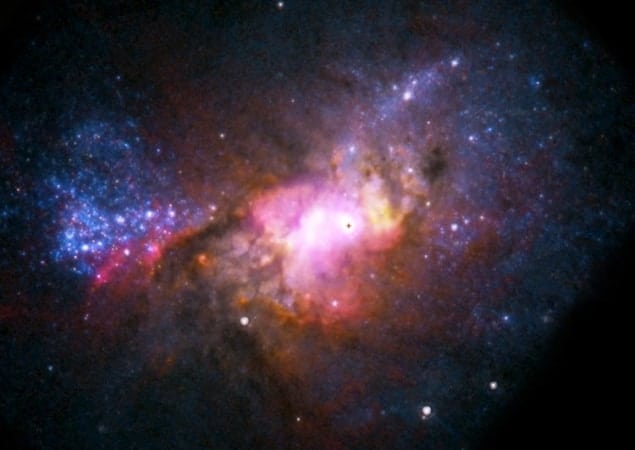
Ever since supermassive black holes were found to lurk at the heart of most large galaxies, astronomers have wondered what came first: the galaxies or the black holes themselves? Now astronomers in the US have spotted the first known supermassive black hole at the heart of a very young “dwarf” galaxy, where stars are still breeding rapidly. The finding, obtained using data from the Very Large Array radio telescope in New Mexico and the Hubble Space Telescope, suggests that supermassive black holes form before their companion galaxies.
The mystery about which came first – galaxies or their supermassive black holes – initially arose when astronomers found that the mass of the black hole divided by that of the galaxy’s dense central core (or “bulge”) is the same for nearly all large galaxies, including our own Milky Way. It seemed that the black holes and bulges affect each other’s growth – and therefore develop at the same time. However, over the past few years observations seem to be suggesting that young galaxies harbour much more massive black holes than this ratio would allow – suggesting that their black holes formed first.
Super-fast jets
The latest evidence backing this black-holes-were-first theory comes from Amy Reines and colleagues at the University of Virginia and the National Radio Astronomy Observatory (NRAO) in the US. They examined the intense radio waves emanating from the centre of Henize 2-10 – a galaxy with a radius about 3% that of the Milky Way and 30 million light-years from Earth. The galaxy is forming stars very rapidly and some astronomers believe that it resembles the first galaxies to form in the early universe.
The radiation streaming from the centre of Henize 2-10 was found to resemble that expected from super-fast “jets” of material spewed outward from areas close to a black hole. The presence of a supermassive black hole was then confirmed by measurements from the Chandra X-ray Observatory. These revealed intense X-ray emission from the galactic core, which – together with the radio data – indicated what the researchers say is a supermassive black hole a million times more massive than our own Sun.
The case strengthens
While central black holes of about the same mass have been found in other galaxies, those galaxies are larger – and have much more regular shapes – than Henize 2-10. They also do not support the same high rate of star formation as Henize 2-10. “Now, we have found a dwarf galaxy with no bulge at all, yet it has a supermassive black hole,” says Reines. “This greatly strengthens the case for the black holes developing first, before the galaxy’s bulge is formed.”
That view is echoed by Reines’ colleague, Kelsey Johnson of the University of Virginia. “This galaxy probably resembles those in the very young universe, when galaxies were just starting to form and were colliding frequently,” she says. “All its properties, including the supermassive black hole, are giving us important new clues about how these black holes and galaxies formed at that time,” Johnson says.
The research is described in Nature doi:10.1038/nature09724 and is being presented by Reines today in Seattle at the 217th meeting of the American Astronomical Society.



